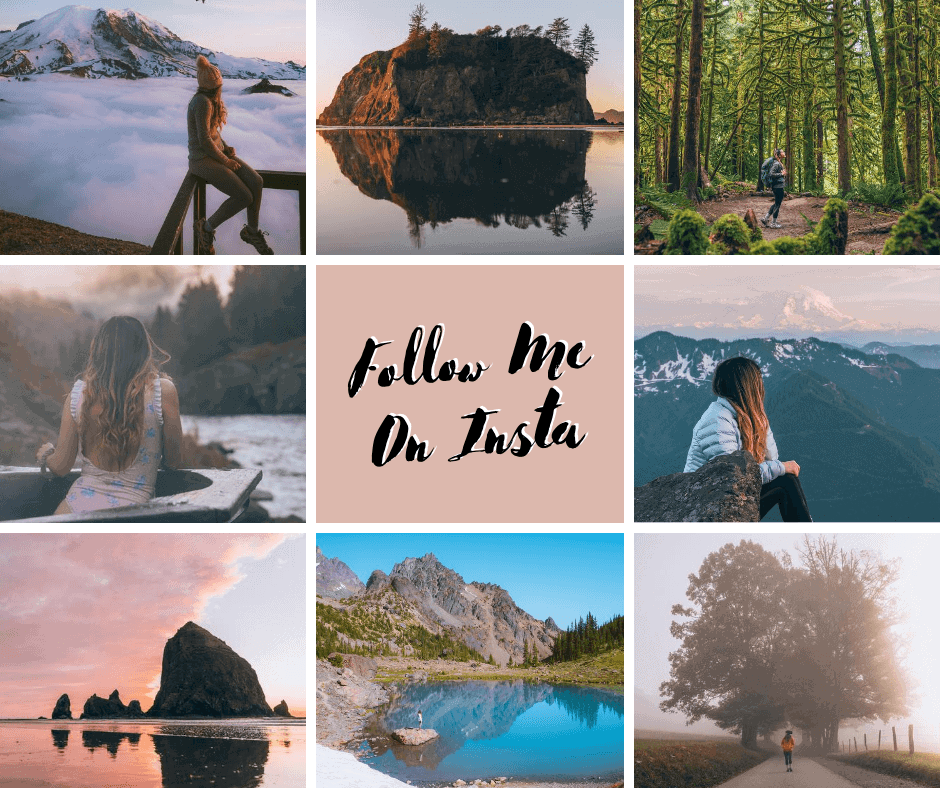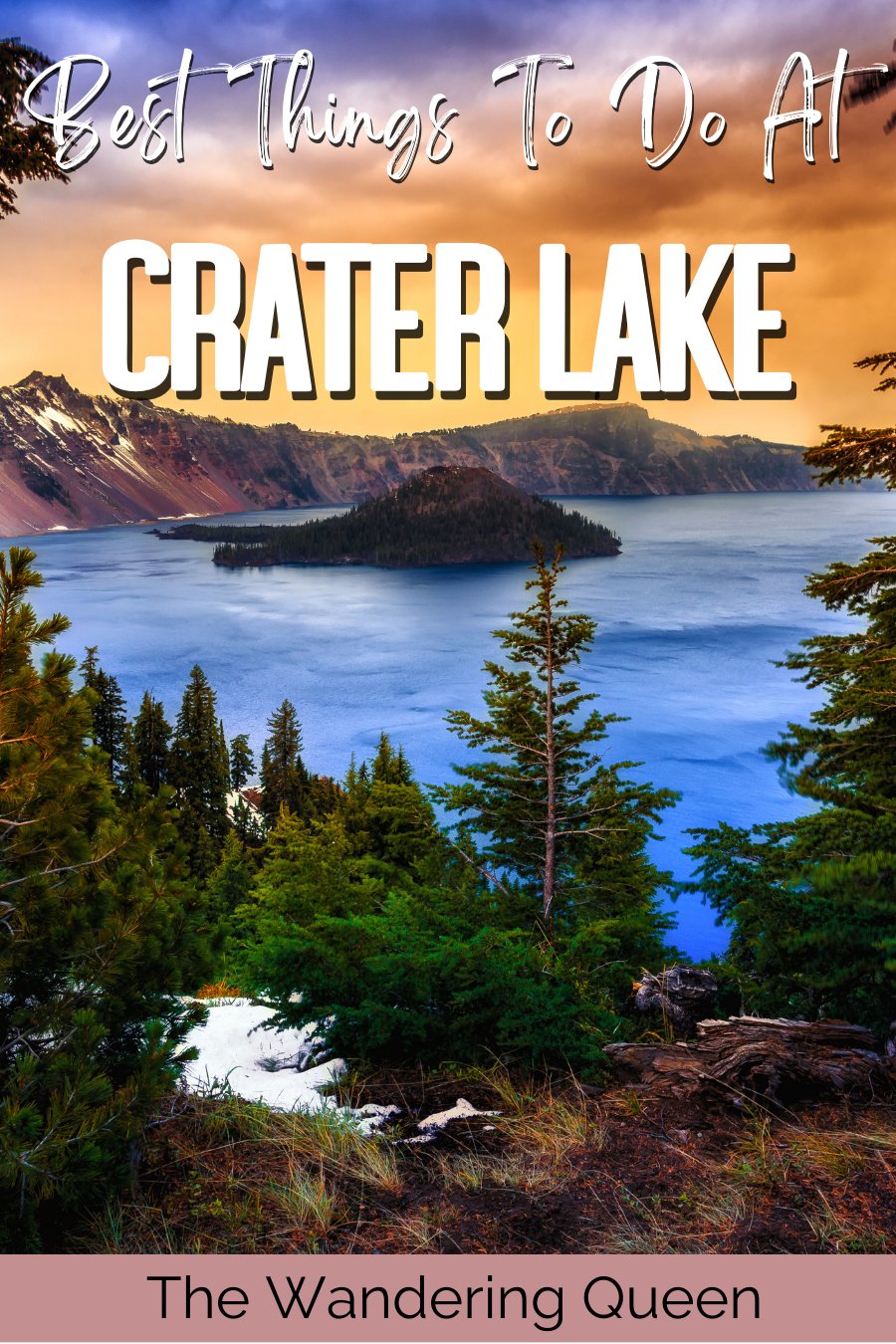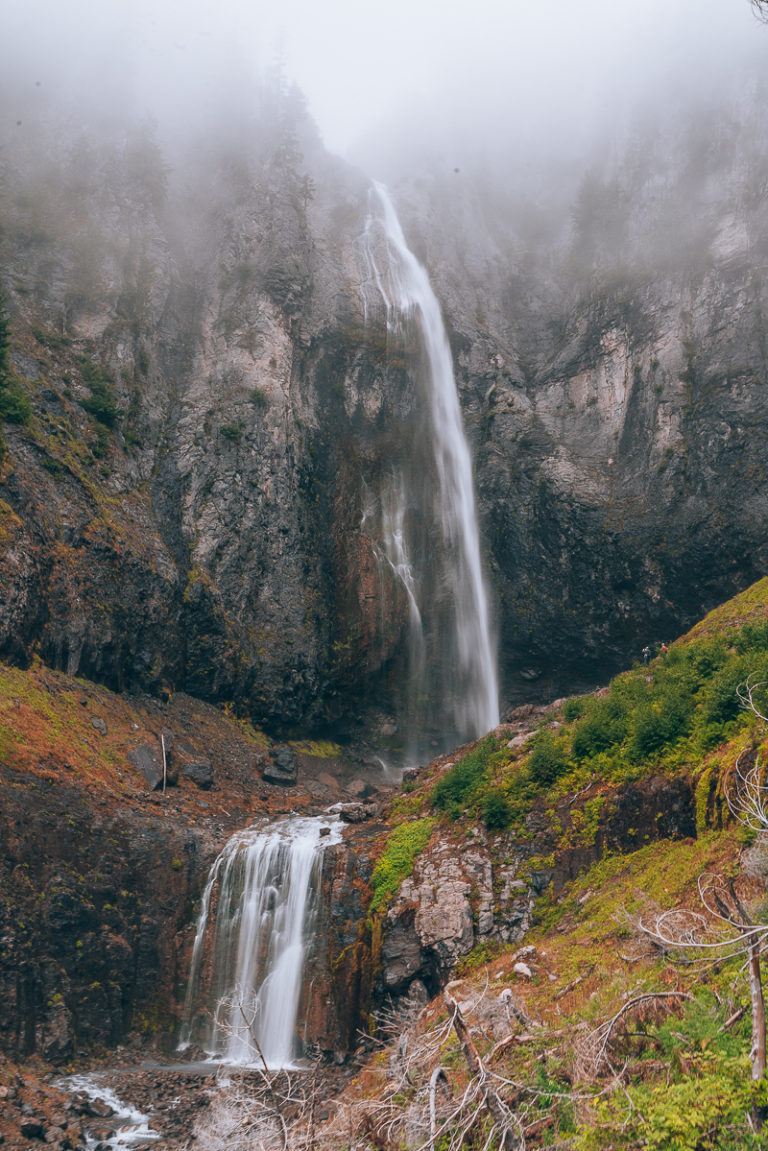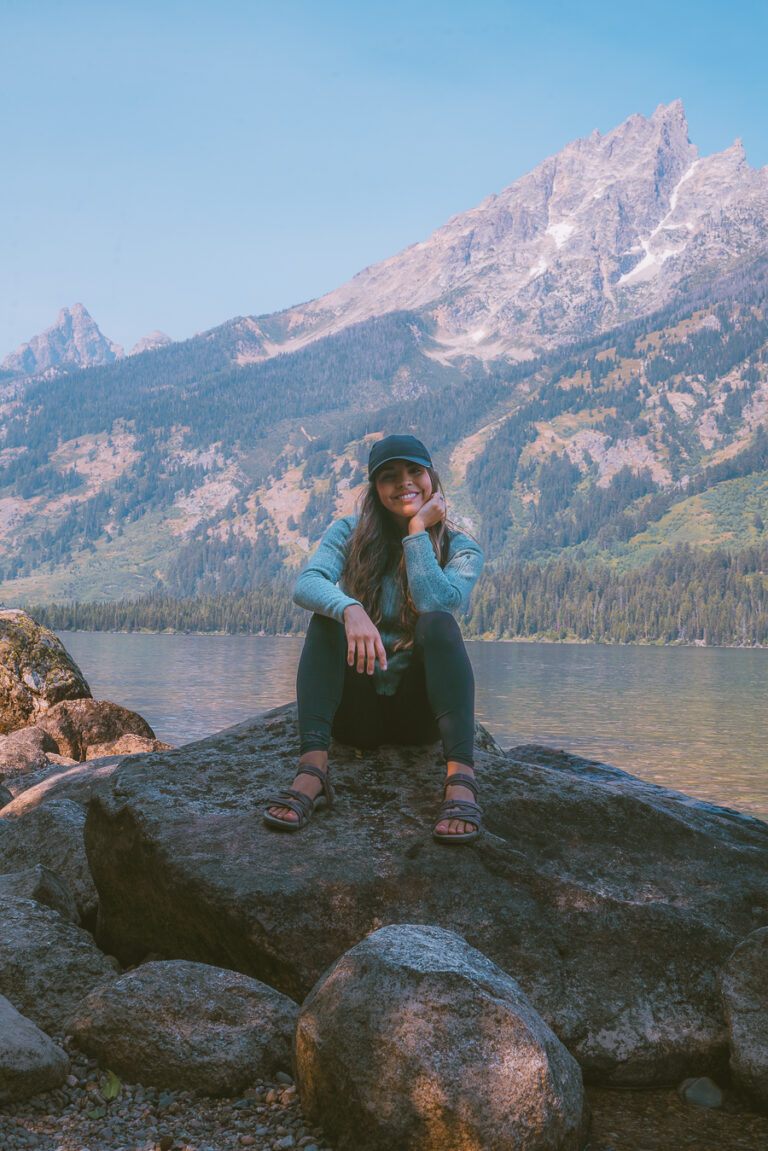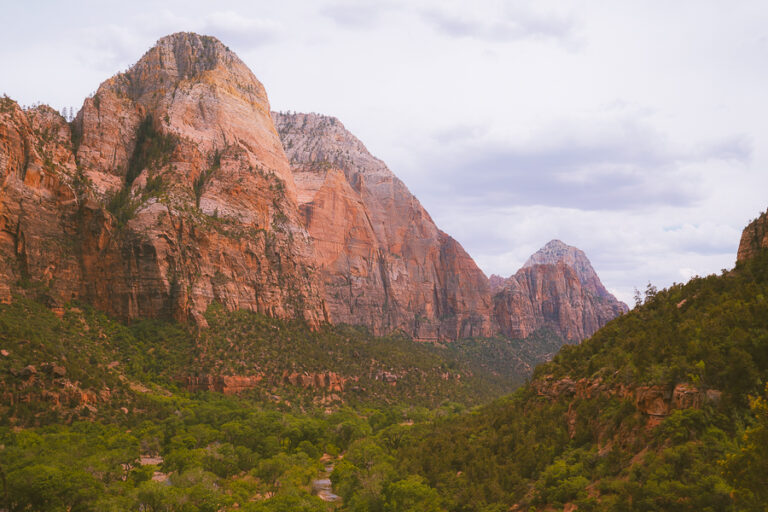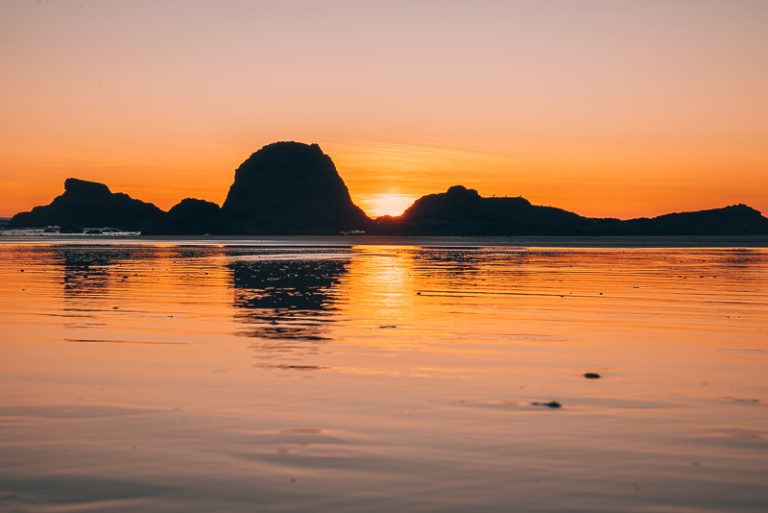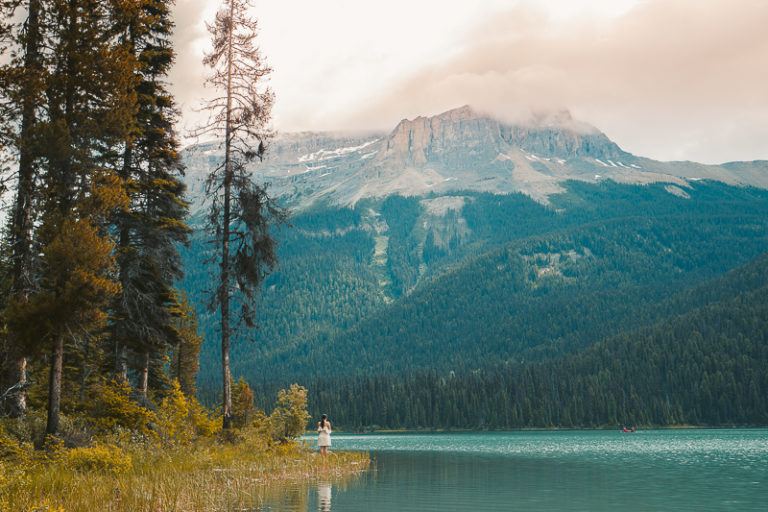14 Best Things To Do at Crater Lake National Park
If you’re thinking of visiting Crater Lake, you’re in for a spectacular adventure. There are so many sights and things to do at Crater Lake that you’re sure to have a memorable time.
Located in southern Oregon, Crater Lake National Park is the only national park in the state and one of its top attractions. The crater was created about 7,700 years ago when Mount Mazama collapsed after a dramatic eruption.
The ash created a caldera which eventually filled with rain and snow and became the deepest lake in the United States, with a depth of 1,943 feet.
There are no rivers or streams leading to this lake; all water comes from rain and snow — of which this park receives lots. So you’ll come across a crystal clear lake with an impressive blue color that makes for excellent photography opportunities.
With over 90 miles of hiking trails and a scenic drive offering views of this lake, you’ll have views galore no matter what activity you take on.
So, let’s jump right in!
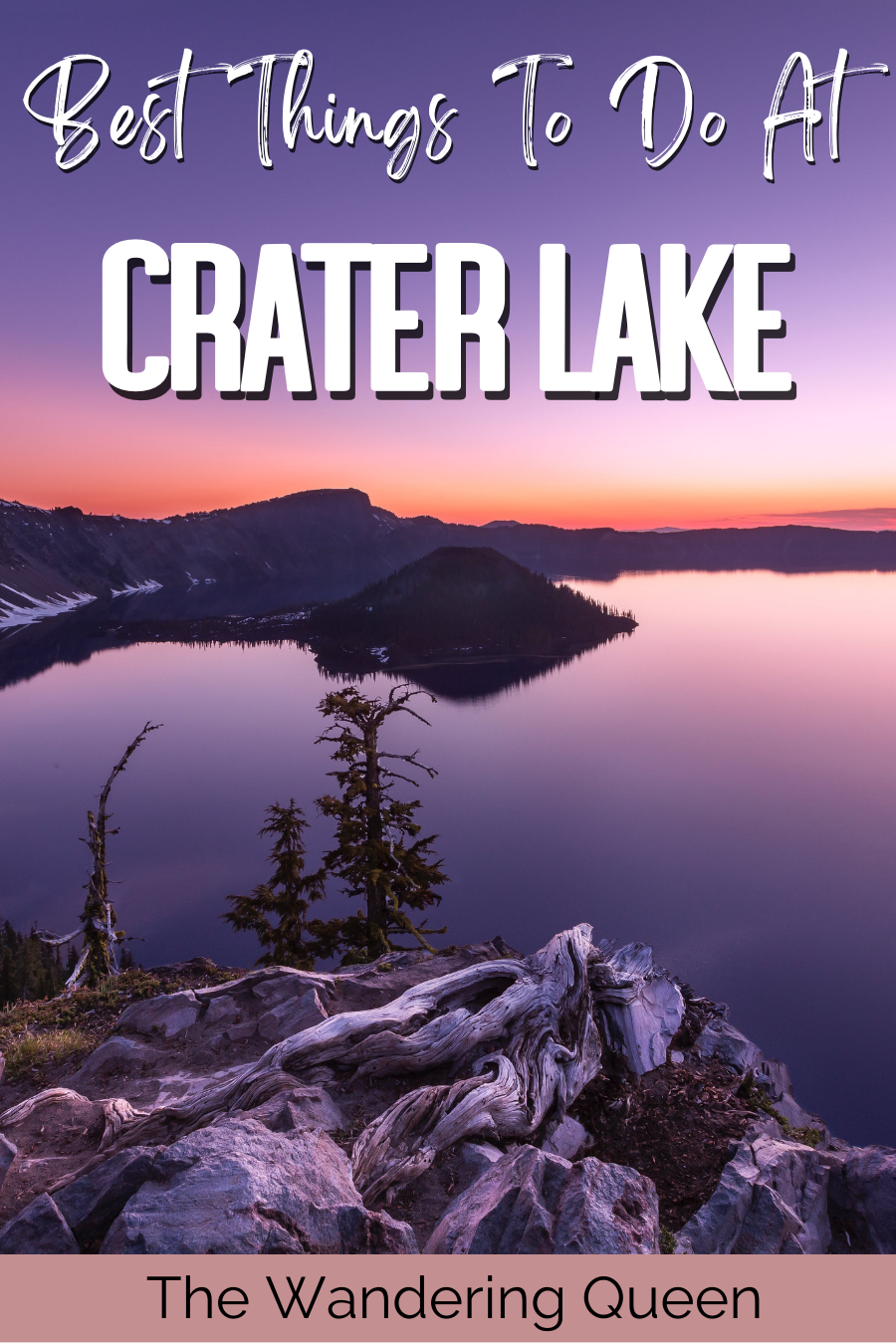
Disclosure: This post contains affiliate links. If you click one of them, I may receive a small commission (for which I am very grateful for) at no extra cost to you.
Crater Lake National Park
Related Posts
Map of What To Do at Crater Lake
Best Time to Visit Crater Lake
The best time to visit Crater Lake is during summer when the temperatures are more pleasant. Due to the park’s high elevation, it receives snow and rain well into early summer. And, while there are definitely plenty of fun activities to enjoy in the snow, overcast conditions may get in the way of that perfect blue or sunset reflection over the lake.
Another reason to visit during the warmer months is that the scenic Rim Drive is only open from mid-July to around mid-October. In summer, Crater Lake National Park is also abuzz with active ranger programs.
Of course, visiting Crater Lake in summer means you’ll encounter plenty of tourist crowds, which can make a visit to the park a bit more stressful. If you can only visit during the peak months of July and August, try to get in the park well before 9 am to secure parking and enjoy uncrowded trails.
The ideal time to visit to avoid busy trails is during September, after Labor Day, as crowds start to dwindle.

Note: There has been an increase in wildlife fires in and around the park in recent years. The smoke from these fires can obstruct your views of the lake and make for an unpleasant hiking experience. So, it’s best to call the visitor center ahead of time for updates on wildfires in the area before heading to the park.
Things To Pack When Visiting Crater Lake National Park
- Bug Spray: Bring some good bug spray, just in case. >Buy Some Here
- Sunscreen: One of the ten essentials! I always bring this with me. >Buy Sunscreen
- Hiking Boots/Shoes: If you use tennis shoes, you can easily hurt your toes hitting a rock by accident (Trust me I have done it so many times). >Check Out My Hiking Shoes
- Hiking socks: Having the correct socks helps prevent blisters while hiking at Crater Lake. Smart Wool is probably my favorite brand out there. I also love how they now have pink socks too 🙂 >Buy Hiking Socks
- Refillable water bottle: I always bring a Hydroflask on all my adventures. They are on the heavier side, but I know for a fact they will not break. I have had a few cheap water bottles break on me before. >Check Prices Now
- Water Reservoir: You might need more water than a water bottles worth. The great thing about this reservoir is that it doesn’t have the plastic taste. >Here Is My Water Reservoir
- Water: Stay nice and hydrated.
- Sunglasses: It can get sunny, so make sure to pack some sunglasses. >Check Out These Sunglasses
- Snacks: The best snacks are jerky, nuts, energy bars, and extra food. >>>Check Out These Snacks!
- Camera: The camera I have linked was one of the first cameras I started using on my travels. The Sony A6000 is an excellent camera for people that want to start improving at travel photography. >Buy Sony Camera Here
- First Aid Kit: This is one of the first things I bought when I first started going on adventures. It is super portable. >Buy This Awesome First Aid Kit Here
- Day Pack to carry all your things: The REI bag I have linked, we have had for seven years now, and it is still going strong! >Buy This Great Quality Backpack
- Leggings or Hiking Pants: I love wearing leggings while hiking because I love how comfy they are. Here are my leggings. >Click For My Leggings
- Breathable sweat-wicking shirts: Try not to wear cotton because it soaks up your sweat and can cause hypothermia in the mountains. >Buy Shirt Here
- Sports Bra: For women >>>Click Here
- Jacket: If you go in the winter, fall, or spring bring a jacket! The elevation is pretty high here. >Buy My Favorite Jacket
- Rain Jacket: When hiking in Oregon, you need this in case it starts pouring on you, which is always a possibility in the PNW. >Buy A Great Rain Jacket Here
- Tripod: This is an optional item, but it is excellent for getting the ideal sunset pictures. >Check out this tripod
- Fire Starter and Matches: This is just in case of an emergency. >Buy These Stormproof Matches Just In Case
- Compass: I always carry this with me, just in case. >Click Here To Buy
- Knife: You never know if you will need it. >Buy My Knife Here
- Headlamp: A headlamp is an absolute must in case you get lost, or you take longer than you thought you would to complete a hike. Trust me, it happens even to me. >Buy A Headlamp Now
- Trekking Poles: I recommend these for people with bad knees like me. >Buy The Poles Shown In My Picture
- Bathing suit: If you are are swimming in the lake bring one! >Buy One Here
- Crampons: If you are hiking outside of the summer months, I highly recommend always having this in your backpack. >Buy My Handy Dandy Crampons
- Crater Lake Map: A map is essential so you don’t get lost. I usually bring with me AllTrails+ map on my phone, and a physical map. I love National Geographic’s maps. They are good quality. >>>Check It Out Here
Claim your FREE Hiking Checklist
Ready to start hiking? Grab my free hiking checklist and never forget anything at home!
Where to Stay at Crater Lake
Below are some convenient and beautiful accommodation options in and around Crater Lake National Park.
Mazama Village Campground & Cabins (Budget)
The Mazama Campground also offers 10 beautiful and spacious cabins if you’d prefer camping with a bit more luxuries. Each cozy cabin features two queen beds and a private bathroom but does not offer air-conditioning. These cabins are usually only open during the warmer months, and it’s recommended that you book well in advance to secure a spot. >>>Find Out More
Crater Lake Lodge (Mid-range)
Offering breathtaking views of Crater Lake (that are especially dramatic around sunset and sunrise), this lodge is the most convenient accommodation option in the park. The rooms are spacious and homely, with a rustic flair. The lodge is also near many hiking trailheads, including Garfield Peak and Discovery Point. >>>Find Out More
Crater Lake Resort (Luxury)
This stunning resort in nearby Fort Klamath is about a 30-minute drive from Crater Lake. The resort offers bright and cozy cabins tucked among greenery and surrounded by manicured lawns.
You’ll have access to a well-equipped kitchen, a TV, free WiFi, and a children’s playground, making it ideal for a family getaway. Nearby, you’ll find a small river where you can enjoy canoeing. >>>Check Rates and Availability
Read More: Where to Stay Near Crater Lake National Park | Lodging & More
How To Get to Crater Lake
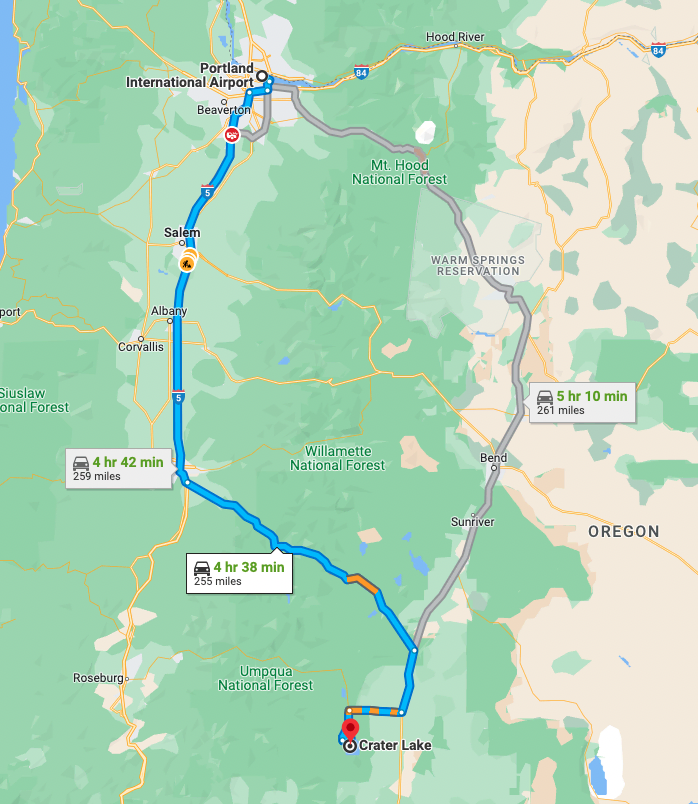
There are two main options for getting to Crater Lake. You can fly into Portland International Airport (PDX) and drive about five hours south to reach the Park’s North Entrance. This option may be a bit more affordable than flying into a regional airport, but it involves more driving time.
You can also fly into Rogue Valley International Medford Airport or a regional airport like Crater Lake – Klamath Regional Airport (LMT). Crater Lake National Park’s South Entrance is about an hour and a half’s drive from Medford and about an hour from Klamath.
Entering Crater Lake
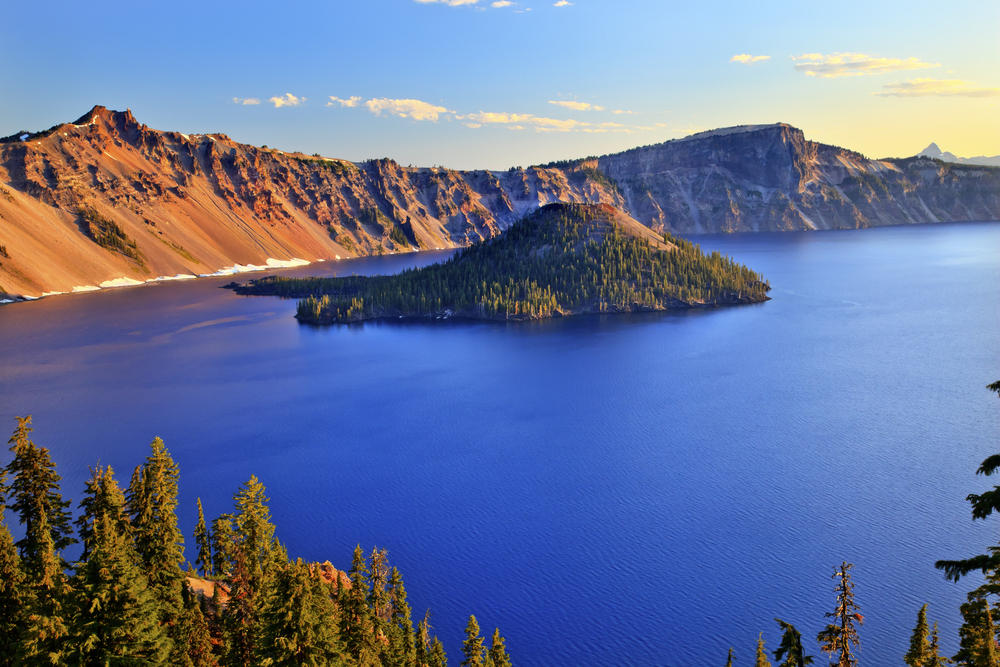
Entry to Crater Lake National Park costs $30 per private vehicle and its occupants during summer and $20 during winter. This pass is valid for seven days.
If you’re planning on visiting more parks in the pacific Northwest, like Mount Rainier National Park, consider purchasing an America the Beautiful Pass instead. This pass costs $80 and allows you unlimited access to all National Parks in the United States for a year. That amounts to a lot of money saved if you’re an avid explorer.
How to Get Around in Crater Lake
Your easiest option for getting around Crater Lake is by renting a vehicle or bringing your own. You can easily drive almost 100 miles within the park, so be sure to fill your tank before entering the park. The Mazama Village Store sells unleaded gasoline during summer, but it’s still safer to bring your own backup in case they don’t have any.
If you have an electric vehicle, the park has a charging station in front of the Mazama Village Annie Creek Gift Shop. The station offers a standard and Tesla connector. However, the availability of these can be hindered during heavy snowfall.
What To Do at Crater Lake | Things To Do At Crater Lake
Now for the exciting part, here’s what to do in Crater Lake National Park for a memorable time.
Stop at the Visitor Center
The Visitor Center is a great first stop to get some practical information and updates on the weather conditions, closed trails and roads, and organized programs. But these centers are also excellent places to learn more about the park. Crater Lake National Park has two visitor centers:
- Steel Visitor Center: Open all year and located near the Park Headquarters.
- Rim Village Visitor Center: Open from May to September and located along the Rim Drive near Crater Lake Lodge.
Steel Visitor Center offers film of the park’s human geological history. And if you’re looking to pick up a souvenir, the Rim Village Visitor Center has an on-site gift shop.
Follow the Scenic Rim Drive
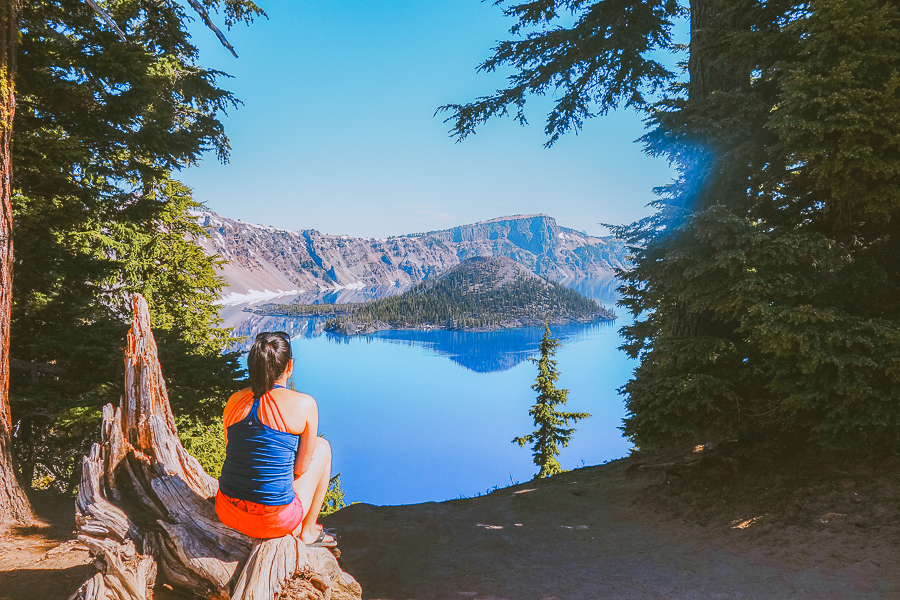
The 33-mile Rime Drive is one of the most stunning roads you’ll ever drive. The road loops around the rim of the lake and passes many great Crater Lake viewpoints, trailheads, and picnic areas. It’s the ideal option if you’re short on time but want to see as much of the lake as possible.
This road is only open from mid-July to about mid-October, so you’ll only have access to it during summer. Try to make it to the park before sunrise to admire the sun as it washes over the water-filled crater. Some of the most scenic spots for sunrise vistas include:
- Phantom Ship Overlook
- Discovery Point Overlook
- Cloudcap Overlook
Hike the Cleetwood Cove Trail
- Distance: 2 miles out-and-back
- Elevation Gain: 620 feet
- Difficulty: Moderate to challenging
- Trail Guide: Link
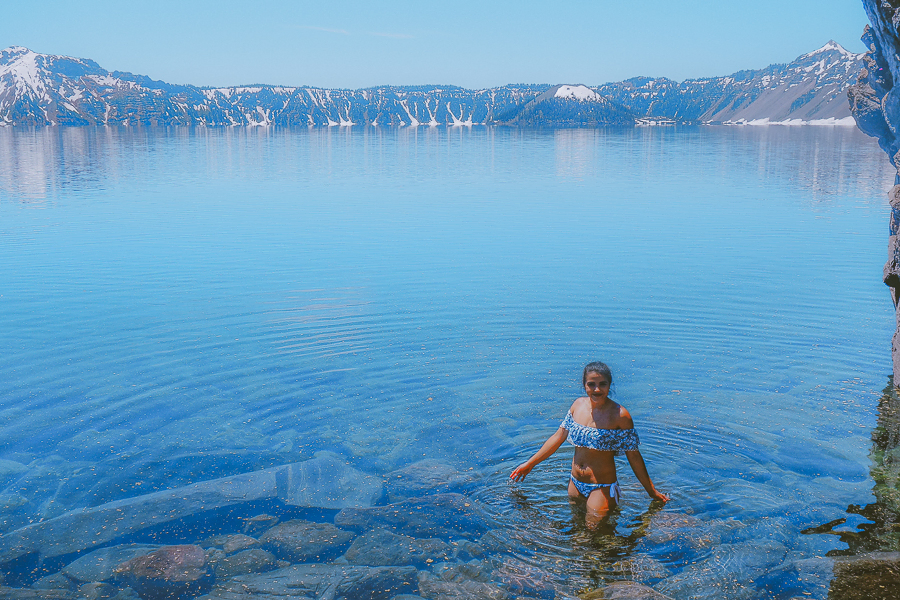
While the hike may be a bit steep, this is the only trail that takes you down to the lake, so it’ll be well worth the effort. This 2-mile trek starts along the Rim Drive and follows steep switchbacks down to the scenic shores of the lake, where you can swim or join a boat tour.
You’ll have to follow those same switchbacks back up. So, if you’re not an experienced hiker, it may be a bit on the challenging side for you. Be sure to wear your best hiking boots and take as many breaks as needed. The hike should take between 30-45 minutes each way.
Go on a Boat Tour of Crater Lake

To really appreciate the lake up close, you can opt for a boat tour during summer. These tours are run by park rangers who’ll share some interesting facts about the lake and park as you glide on the tranquil waters.
The boat tours are run by Crater Lake Hospitality and depart from the bottom of Cleetwood Cove Trail. So you’ll have to put in the legwork to join this activity.
There are various tour options. The standard cruise involves a 2-hour educational tour that passes by natural formations like Wizard Island and Phantom Ship. Prices start at around $30 for children and $44 for anyone older than 12 years.
Hike the Watchman Peak Trail
- Distance: 1.7 miles out-and-back
- Elevation Gain: 400 feet
- Difficulty: Moderate
- Trail Guide: Link

This 1.7-mile scenic trail also kicks off along the Rim Drive at the Watchman Overlook. The trail follows multiple switchbacks that lead up to a historic fire lookout that offers incredible views over Wizard Island and the surrounding lake.
The Watchman Peak towers over 8,000 feet above sea level, making it one of the park’s highest points. It is located on the western edge of Crater Lake and is a popular spot for panoramic sunset vistas.
Take the Plaikni Falls Trail
- Distance: 2 miles out-and-back
- Elevation Gain: 138 feet
- Difficulty: Easy
- Trail Guide: Link
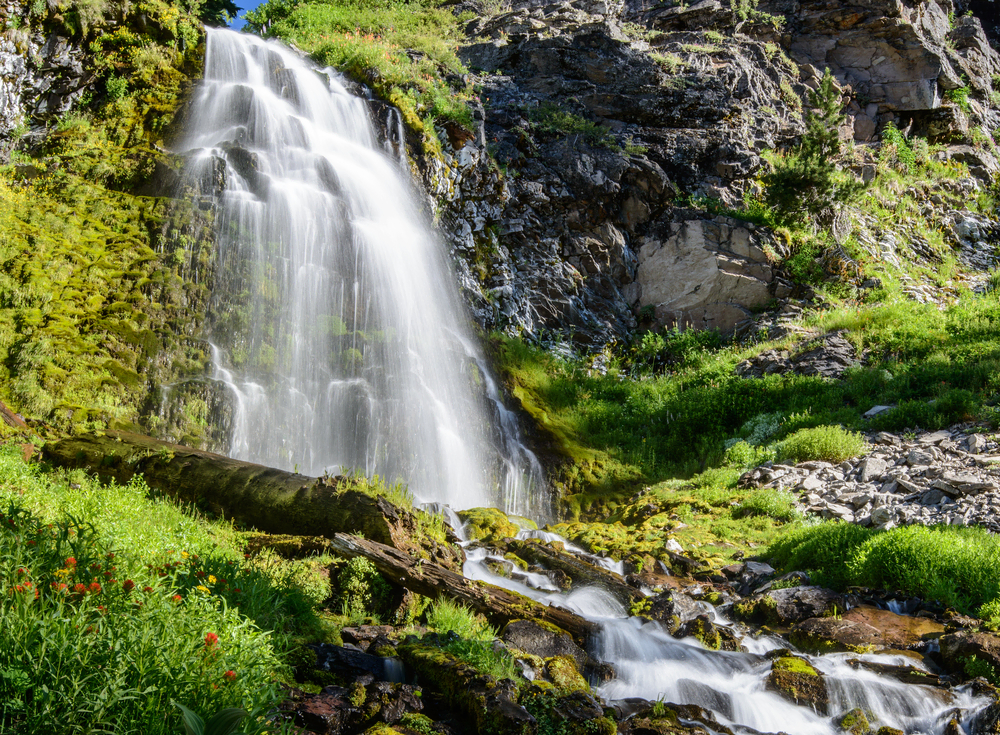
One of the most accessible hikes in Crater Lake is the short and easy Plaikni Falls trail. The 2-mile hike follows along Pinnacles Road and winds through an old-growth forest and lush greenery before ending at a cascading waterfall.
There are plenty of benches along the trail, and you may even encounter some forest critters among the wildflowers in the warmer months. You’ll want to bring your best camera gear along to capture the beauty of this waterfall.
Download my free Outdoor Photography Guide
Take a Boat to Wizard Island
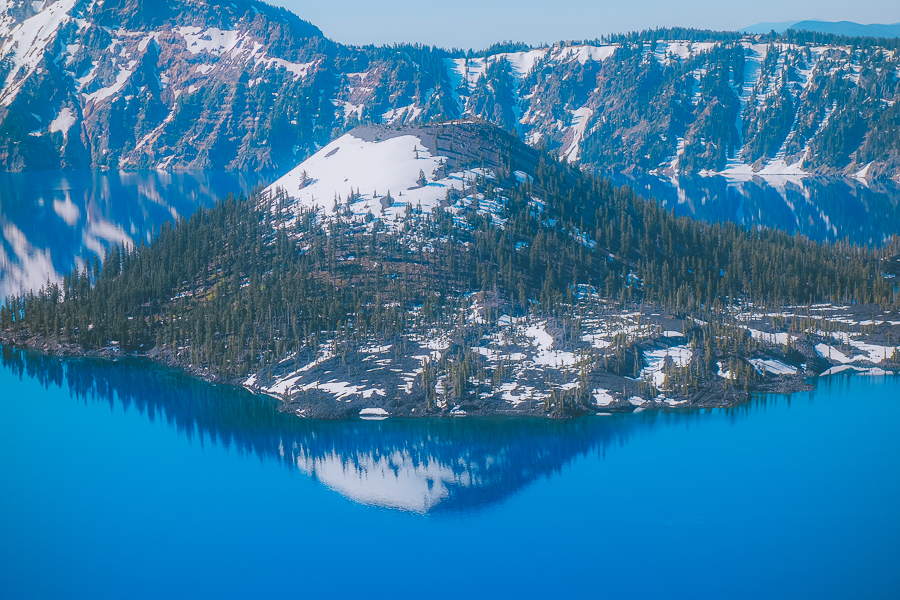
Have you ever heard of a volcano within a volcano? Wizard Island is one of Crater Lake’s most fascinating attractions. It’s a 763-foot cinder cone of a submerged volcano sitting about 2,500 feet deep in the lake.
You can get an up-close view of Wizard Island by taking a boat tour of the lake before being dropped off on the island for three hours. On the island, you can wander around and hike to its summit along the 2.3-mile Wizard Island Trail. At the top, you’ll find a 90-foot-deep crater.
You can opt for a boat tour, which is a bit more costly, starting at $55 for adults. Or you can take the more affordable Wizard Island Shuttle, with prices kicking off at $28.
Take a Trolley Tour of Rim Drive
You’re bound to miss a sight or two if you’re in the driver’s seat. Luckily, there’s an easier way to see Crater Lake and enjoy the Rim Drive. The Crater Lake Trolley is a charming shuttle operated by the park rangers, who’ll provide a 2-hour informational tour of the crater’s rim.
The Crater Lake Trolley tour starts near Crater Lake Lodge. You’ll stop at certain spots to take photos and ask any burning questions about the history and geology of this stunning lake. Tickets are about $25 for children and $36 for adults.
Follow Mount Scott Trail
- Distance: 4.2 miles out-and-back
- Elevation Gain: 1,260 feet
- Difficulty: Moderate
- Trail Guide: Link
With an elevation of almost 9,000 feet, Mount Scott is the highest point in Crater Lake. The summit offers incredible views of the lake, with views reaching even further to Oregon sights like the High Desert and the Cascade Range.
To reach the panoramic summit, you’ll start your hike at the trailhead along East Rim Drive. From there, you’ll follow a ridgeline and a clear path up the peak. This hike has quite the elevation gain, so it may be a bit challenging for inexperienced hikers.
Due to its height, the peak also gets snow year-round, so be sure to have a look at this guide on hiking in the snow. The Mount Scott trail is one of the most challenging trails in the park, but the vistas at the top are well worth the effort.
Camp at Mazama Campground
With over 200 campsites accommodating tents, trailers, and RVs, the Mazama Campground is the ideal place to stay if you’re looking to further immerse yourself in nature. You’ll be close to plenty of hiking trails and the Rim Drive and Rim Village.
This campground sits tucked among an old-growth forest and offers a range of convenient amenities. These include picnic tables, laundry facilities, coin-operated showers, food lockers, and the Mazama Village Store. There’s also a small amphitheater where ranger programs are held during summer.
The campground is only open during summer. The exact opening day usually depends on the amount of snow still present around the site, but it generally opens in June. Tent sites cost about $21 per campsite, accommodating up to six people. RV sites start at $31 per night.
Hike the Discover Point Trail
- Distance: 2.4 miles out-and-back
- Elevation Gain: 338 feet
- Difficulty: Easy
- Trail Guide: Link
The Discovery Point trail is an easy trail that’s ideal for families or those looking for a more relaxed hike. The trail starts near the west end of Rim Village and leads to the popular Discovery Point outlook. This is the point where some gold prospectors came across Crater Lake on 06/12/1853.
The trail has a minimal elevation gain and follows parallel to the West Rim Drive. Along the way, you’ll have beautiful views of the entire lake and Wizard Island through the rows of pine trees and shrubbery.
There is no defined trailhead for this hike, but you’ll notice the paved walk near the west end of Rim Village turns to a dirt path. That’s where your hike will start.
Wonder at the Sky
Thanks to its high elevation and remote location, Crater Lake is an excellent place to stargaze or, better yet, see the northern lights! There’s almost no light pollution, which means you’ll have the perfect view of the heavens and its reflection on the unmoving lake.
You’ll get to admire the Milky Way and the various constellations and perhaps even photograph it if you’re handy with your camera. One of the best places to get a panoramic view of the lake is from the Sinnott Memorial Overlook — a popular viewpoint for sunrise and sunset views.
If you’d like to spot the northern lights, the best time to do so is during winter, when the nights are long, and the skies are clear. You can check the aurora forecast to get an idea of when you’re most likely to spot this stunning phenomenon.
Tackle the Garfield Peak Trail
- Distance: 3.4 miles out-and-back
- Elevation Gain: 1,070 feet
- Difficulty: Moderate
- Trail Guide: Link
In terms of difficulty, the Garfield Peak Trail is more strenuous than the Watchman Peak Trail but less challenging than the Mount Scott trail. The 2-3 hour hike kicks off along a paved walkway running behind Crater Lake Lodge on the eastern end of the Rim Village Visitor Center.
You’ll have scenic views all along the sometimes steep and rocky trail. Once at the summit, you’ll be rewarded with sweeping views of Crater Lake. On a clear day, you may even spot the peaks of the Cascades Range in the distance.
This summit is a great spot to enjoy a picnic, so pack a lunch to enjoy along with some of the best views in the park.
Grab Your Free Car Camping Checklist! 🚗🌲
Ready to elevate your car camping game? Snag our essential checklist to ensure you’ve got everything you need for a stress-free, fun-filled adventure! Perfect for beginners and seasoned campers alike. Download now and hit the road prepared! 🌟🎒
Enjoy Winter Activities

While access to certain roads and facilities is limited during winter, there are plenty of reasons why Crater Lake is one of the best national parks to visit in winter. This park receives over 43 feet of snow each year. With a thick layer of snow covering the park, it becomes the perfect playground for cross-country skiing and snowshoeing.
There are plenty of snowshoe and ski trails on the northern side of the park. One of the most popular trails is the Rim Trail, which, like the Rim Drive, offers stunning lakeside views. The Dutton Creek Trail is a great option if you’re looking to wander through some forest scenery.
If you don’t have snowshoeing gear, stop by the Rim Village Cafe & Gift Shop to rent snowshoes. There are also ranger-led snowshoe hikes offered between December and April. The rangers will also add in some interesting information on how plants and animals survive in this environment.

Tip: Not sure what clothing to bring for a snowshoeing or cross-country ski adventure? Have a look at this guide on what to wear snowshoeing.
Things To Do in Crater Lake National Park | FAQ’s

If you still have a few questions about visiting Crater Lake, have a look at these answers to some of the most frequently asked questions.
How Much Time Do You Need for Crater Lake?

One day in Crater Lake is enough time to explore the Rim Drive and some of the hiking trails along the lake. But, with great camping and accommodation sites and so much natural beauty to explore, you won’t regret spending more than one day at Crater Lake.
What Is the Best Month To Visit Crater Lake?
The best month to visit Crater lake is during September, after Labor Day, near the end of the peak season rush. Temperatures are still warm enough to enjoy the park activities, and most roads and facilities will still be open.
Can You Swim Inside Crater Lake?
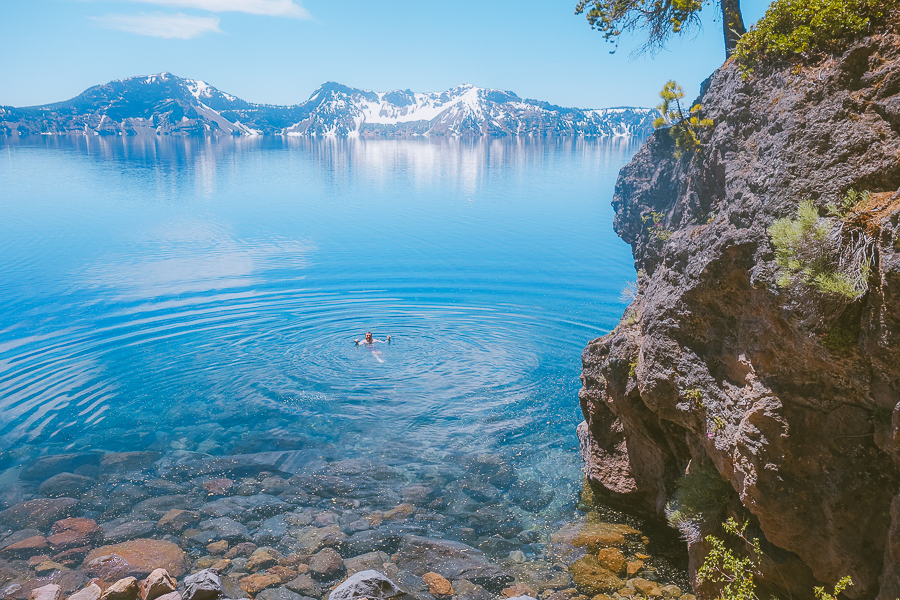
You can swim in Crater Lake’s stunning waters, but beware that it’s quite chilly. The only way to reach the lake to swim in it is by taking the short but steep Cleetwood Cove Trail. This trail may be challenging to inexperienced hikers.
Is There Cell Phone Service at Crater Lake?
There is cell service in Crater Lake, but it’s spotty at best. So be sure to download your hiking trail maps before entering the park so you can access them offline.
Final Thoughts on Crater Lake Things To Do
There you have it; the best things to do in Crater Lake! As you can see, there are multiple ways to appreciate the lake and its environment. From driving around the crater’s rim to admiring the heavens or hiking up the park’s highest peak, you’re sure to have a great time.
Once you’ve checked Crater Lake off your national parks checklist, why not consider some more exciting destinations in the Pacific Northwest?





